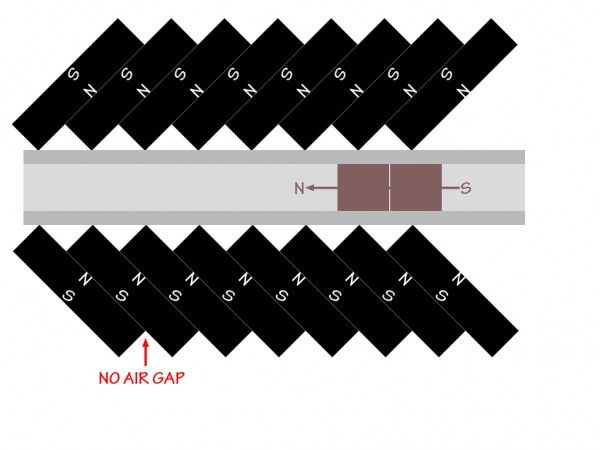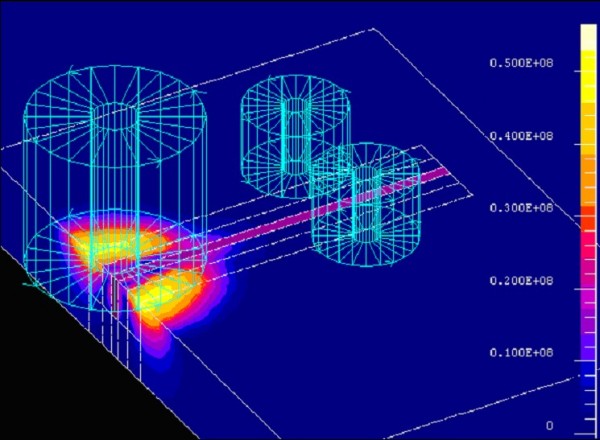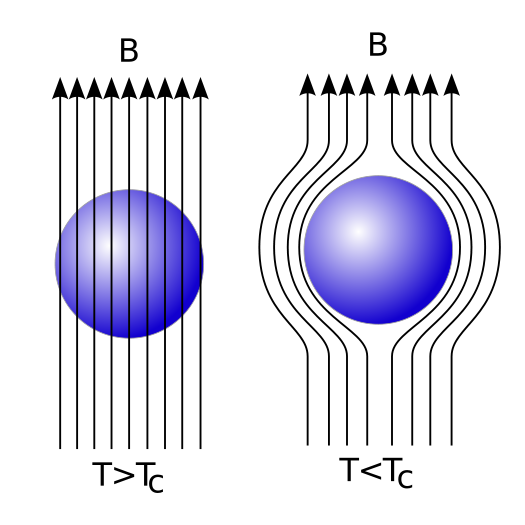Yesterday, I showed you a video of an amazing incidence of magnetic levitation. There's another video, courtesy of Matthew Sullivan and his students, that demonstrates this equally as well:
First off, you need to design a stable magnetic track. This is actually simpler than you might think; you just need three magnetic "lines", where the outer two go in one direction, and the inner one goes in the opposite direction:

Next, you need a high temperature superconductor, typically made of Yttrium, Barium, and Copper Oxide. This way, when you get this thing down to the temperature of liquid nitrogen (77 Kelvin), all of the resistance goes away. (That's why, in the videos, the levitating thing is always smoking; that's the fact that it's only 77 Kelvin!)

When you bring a material like this close to -- but not in contact with -- a magnet, it magnetizes as well. Typically the little eddy currents (below) that magnetize this material decay after a short amount of time.

But when it's superconductor, there is no magnetic field inside! That's what the Meissner effect tells us (for those of you who followed the hint yesterday). In other words, the superconductor expels all the magnetic fields inside of itself, creating a perfect diamagnet, which simply means that it repels the permanent magnets below it.

And that's why it levitates! But, how do you get it to always stay the same distance away from the permanent magnet, even when it's upside down?!
Well, that requires one more thing, called flux pinning, which means you need imperfections in your superconductor. The effect of flux pinning keeps the magnet from floating away, and keeps the superconductor at a fixed height away from the magnet. The forces of the magnet and of the flux pinning are very large compared to gravity, and that's why you can turn it at an angle or even upside-down!

The description you give might be a bit confusing. Meissner exclusion with perfect diamagnetism occurs only in the type-I region, and flux pinning only in the type-II region. This demonstration is in the type-II region, there are magnetic field lines threading into the bulk of the superconductor. The ceramic excludes some, but not all, of the magnetic flux. Other than that, I agree with the analysis.
I'm with Toad. Because I'm a nit-picker, I'll stick with my explanation from yesterday.
Ignoring the Type 1 / Type 2 / high-Tc distinctions, I don't think that the data in the video is consistent with the system being Meissner-dominated. The Meissner diamagnetism will supply a purely repulsive force, so when the French experimentalists inverted the track (so that the diamagnetic force would be in the same direction as gravity), the equilibrium separation from the track would be significantly different. I also have a hard time seeing how one could get such strong transverse confinement in a Meissner-dominated regime.
From the video data, I think we have to conclude that flux pinning (and/or eddy currents in the superconductor resisting a _change_ in the magnetic flux) are the dominant mechanism here, and any forces due to the Meissner effect are small in comparison.
I completely don't understand it, but then again I had a hard time with the physics of magnetic forces back when I was in college.
Hi Ethan et al.,
Thanks for the nice explanation of the phenomenon. We think the demos are pretty amazing as well, and your explanation is great. Without some diamagnetism, there would be no levitation, but without flux pinning, it would never suspend underneath the tracks.
In case you've got students who want to make a similar track demo, we wrote a paper about how we did it in the American Journal of Physics, v. 77, p.847 (2009).
Thats funny. I know drew the linear track diagram for someone at one time or maybe I posted it somewhere. Maybe it was the auther of this article. LOL I still have the original PSD file from that drawing.
Heres the You Tube video of the track. Notice the date.
http://www.youtube.com/user/mjones7947?feature=mhw4#p/a/f/0/iLKiasJrN1s
Never thought I would make real scientific article. You should have posted the video too.
Recon if I show you one that spins you'll publish it?
Cheers
Matthew Jones
Wow, nice video. I wonder how far out we are at taking this to the next level of pubic trans.
When i was a kid i remember playing for hours with magnets that repelled each other. Since they were shaped like lifesavers candy, you could put a string through them and the top one would levitate.
if this ever gets fully developed it'll revolutionise the face of trasportation globally. http://www.mortgagelasvegasnevada.com/cash-out-refinance.php
Never thought I would make real scientific article. You should have posted the video too.